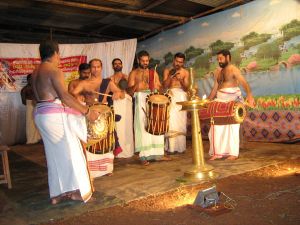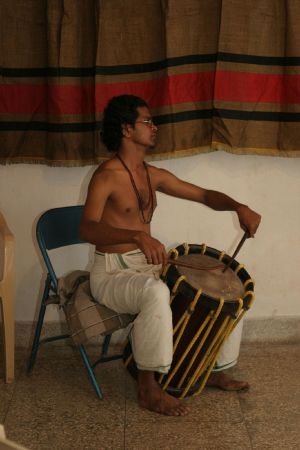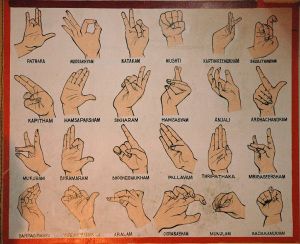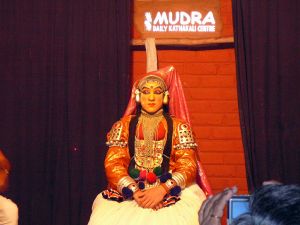Kathakali

Kathakali (Malayalam: കഥകളി , pronounced [kat̪ʰəkaɭi]) is a form of Indian dance-drama. It originated in the Southern Indian state of Kerala during the late 16th century, approximately between 1555 to 1605 C.E.
History
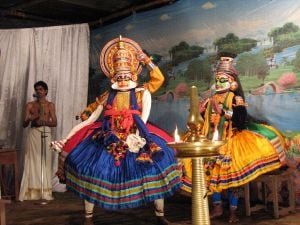
Kathakali originated from Ramanattom (Raman; attom(enactment) and Krishnanattom (Krishnan; attom(enactment). Subsequently, Kottarakara Thampuran (ruler of Kottarakara , once a province in Kerala) composed several plays on Mahabharata which led to the evolution of Kathakali. Ramanattom continued as a part of Kathakali. Kathakali shares a lot of similarities to Krishnanattom, Koodiyattom(Sanskrit drama existing in Kerala)and Ashtapadiattom(an adaptation of 12th century musical called Gita Govindam). It also incorporated several other elements, which is thought to have contributed to its popularity. In particular, the use of Malayalam, which is the local language (albeit as a mix of Sanskrit and Malayalam, called Manipravaalam) made it more popular among the masses. During its evolution, Kathakali also imbibed elements from folk and martial arts which existed at the time in Kerala. Characters with vividly painted faces and elaborate costumes to re-enact stories from the epics like Mahabharata and Ramayana. Kathakali is featured in the award-winning Indo-French-German produced film Vaanaprastham directed by Shaji N Karun and acted by Mohanlal. Kathakali has traditionally been performed in temples and palaces, but nowadays it may also be seen in other entertainment functions. Earlier Kathakali was in an uncivilised form; later it has been reformed in the new version by the great artist Kapplingattu Nampoothiri introducing all those changes that we see today. At the beginning there was no such make ups for 'veshams'. Later he introduced such perfect make up and separate singer for Kathakali.
Etymology
The name Kathakali derives from the Malayalam words "katha" (meaning story) and "kali" (meaning play)
Elements of Fine Art
Kathakali is considered to be a combination of five elements of fine art:
- Expressions (Natyam, the component with emphasis on facial expressions)
- Dance (Nritham, the component of dance with emphasis on rhythm and movement of hands, legs and body)
- Enactment (Nrithyam, the element of drama with emphasis on "mudras", which are hand gestures)
- Song/vocal accompaniment (Geetha)
- Instrument accompaniment (Vadyam)
Even though the lyrics/literature would qualify as another independent element called "Sahithyam", it is considered as a component of Geetha, as it plays only a supplementary role to Nritham, Nrithyam and Natyam.
Kathakali plays
Traditionally there are 101 classical Kathakali stories. Most of them were initially composed to last a whole night. Nowadays there is increasing popularity for concise versions of every story (lasting 2-4 hours instead of a whole night), which has been made by selecting the most dramatic or popular portions of individual stories. In spite of being a classical art form, Kathakali can be appreciated by novices and connoisseurs. This is because of the frequent use of “Lokadharmi” (or the elaboration of folk elements)which allows novices to gain a foothold when they start watching Kathakali. In contrast “Natyadharmi” (which is based on the Natyasastra-the science of Natya and is the more classical component of the art form) delights the experience of novices and connoisseurs alike. It is good to have an idea of the story being enacted. This will help the spectators to appreciate the “personalization” of characters by individual actors. In fact one of the major attractions for traditional Kathakali connoisseurs is their ability to distinguish and debate on the "personalizations" that each actor brings about in his depiction of the story. Often this is a challenging task as most the characters and stories are derived from Hindu epics, which are memorized for people from that region. Success/ failure of amateur Kathakali artistes is often decided by their sensibility to successfully personalize characters.
The most popular stories enacted are Nala Charitam (a story from the Mahabharata), Duryodhana Vadham (a story from the Mahabharata), Kalyanasowgandhikam (the story of Bhima going to get flowers for Panchali, from the Mahabharata), Keechaka Vadham (another story of Bhima and Panchali, from the Mahabharata), Kiratham (Arjuna and Lord Shiva's fight, from the Mahabharata), Karna Shapadham (another story from Mahabharata).
Recently, as part of an attempt at popularizing the art, stories from other cultures, such as the story of Mary Magdalene from the Bible, Homer's Iliad, and Shakespeare's King Lear have also been adapted into Kathakali scripts. The Kathakali plays taken in totality are comparable to Shakespeare's plays, especially with respect to poetry, underlying realism and staging techniques used.
Music
The language of the songs used for Kathakali is Manipravalam. Even though the songs are set for “ragas” based on Carnatic music, there is a distinct style of rendition, which is known as the “sopanam” style. The Sopanam style incorporates the moods of temple songs which used to be sung (continues even now at some temples) at the time when Kathakali was born.
Performance
Traditionally, a Kathakali performance is usually conducted at night and ends in early morning. Nowadays it is not difficult to see performances as short as 3 hours. Kathakali is usually performed in front of a Kalivilakku (“kali”= dance; “vilakku”= lamp). Traditionally, the lamp used to provide light when the plays used to be performed inside temples, houses of nobles and palaces. Enactment of a play by actors takes place to the accompaniment of music (geetha) and instruments (vadya). The percussion instruments used are Chenda, Maddalam and Edakka. In addition the singers (usually the lead singer is called “ponnani” and his follower is called “singidi”) use "Chengala" (a round disc made of bell metal, which can be struck with a wooden stick) and "Ilathaalom" (a pair of cymbals). The lead singer in some sense uses the Chengala to conduct the Vadyam and Geetha components, just as a conductor uses his wand in western classical music. A distinguishing characteristic of this art form is that the actors never speak but use hand gestures, expressions and rhythmic dancing instead of dialogue.
Acting
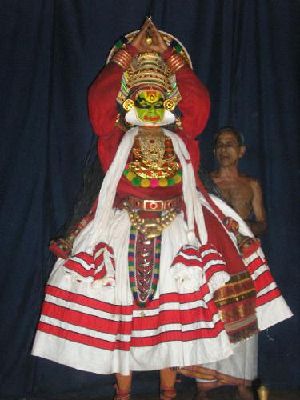
A Kathakali actor uses immense concentration, skill and physical stamina, gained from training based on Kalaripayattu, the ancient martial art of Kerala, to prepare for his demanding role. Training can often last for 8-10 years. The training programme is intensive. In Kathakali, the story is enacted purely by the movements of the hands (called mudras or hand gestures) and by facial expressions (rasas) and bodily movements. The expressions are derived from Natyasatra (the science of expressions) and are classified into nine as in most Indian classical art forms. Dancers also undergo special practice sessions to learn control of their eye movements.
There are 24 main mudras and numerous other lesser mudras. Each can again can be classified into 'Samaana-mudras'(one mudra symbolizing two entities) or misra-mudras (both the hands are used to show these mudras). The mudras are a form of sign language used to tell the story.
The main facial expressions of a Kathakali artist are the 'navarasams' ( 'Navarasas' in anglicised form )(literal translation: Nine Tastes, but more loosely translated as nine feelings or expressions) which are Sringaaram (amour), Haasyam (ridicule, humour), Bhayam (fear), Karunam (pathos), Rowdram (anger, wrath), Veeram (valour), Beebhatsam (disgust), Adbhutham (wonder, amazement), Saantham (tranquility, peace). The link at the end of the page gives more details on Navarasas.
Make-up
A Kathakali artist, Mattbaier, putting on facial colours in Kochi, Kerala.
One of the most interesting aspects of Kathakali is its elaborate make-up code. Most often, the make-up can be classified into five basic sets namely Pacha, Kathi, Kari, Thaadi, and Minukku. The differences between these sets are the predominant colors that are applied on the face. Pacha (Pacha=green)has green as the dominant color and is used to portray noble male characters who is said to have a mixture of "Satvik" (pious)and "Rajasic" (kingly)nature. Rajasic characters having an evil streak ("tamasic"= evil), such as the demon king Ravana, are portrayed with red as the predominant color in a green background. Excessively evil characters such as demons (totally tamasic) have a predominantly red make-up and a red beard. They are called Chuvanna Thaadi(Red Beard). Tamasic characters such as uncivilized hunters are represented with a predominantly black make-up base and a black beard and are called Kari/ Karutha Thaadi (meaning black beard). Women and ascetics have lustrous, yellowish faces and form the fifth class. In addition there are modifications of the five basic sets described above such as Vella Thadi (white beard) used to depict Hanuman (the monkey god) and Pazhuppe, which is used for the Lord Siva.
The make up is made from various mineral ores and pigments. They are ground on a stone and mixed with coconut oil before being applied on the face. Some characters also have their features enhanced, such as an enlarged nose or an elaborate mustache. There are made using elaborately cut paper which is stuck to the face with a mixture of rice paste and calcium carbonate. Dancers also often place a "chundanga seed" (variety of eggplant which bears small fruits) under their lower eyelid before the performance to turn the white of their eyes red. In fact the "chundanga" is not really a seed and is prepared by removing the ovaries at the base of the flowers of this plant. The procedure used for preparing these seeds involves the rubbing of a bunch of these in your palm until they become black (starting from a white color) and nearly dehydrated. They often last long enough for a season (of around four months) in this condition.
Renowned training centers for Kathakali
The most popular Kathakali artists have obtained their training from one the four centers below, which follow the traditional "gurukula" style. Moreover these four centers are the oldest ones with some of them present from pre-independent era of India. Kerala Kalamandalam (located in Cheruthuruthy, near Shoranur, Kerala) PSV Natya Sanghom (located in Kottakal, near Kozhikode, Kerala) Gandhi Seva Sadan Kathakali and Classic Arts Academy (located in Perur, near Palakkad, Kerala) and Unnayi Varier Smaraka Kalanilayam (located in Iringalakuda, near Thrissur, Kerala)
There also several new centers, but they are relatively new compared to these old schools where masters of the art such as Kalamandalam Ramankutty Nair (recipient of prestigious Kalidas award) and Keezhpadom Kumaran Nair (recipients of prestigious Padmashree award) and contemporaries trained their disciples.
Vella Kathakali Vidyalayam and Kalabharathi Kathakali Vidyalayam,FACT Kathakali School, RLV Kathakali vidyalayam Trippunitura also conduct Kathakali classes.
KATHAKALI STYLES (Sampradayam) 1, Vettathu Sampradayam 2, Kalladikkodan Sampradyam 3, Kaplingadu Sampradayam.
The latest Sampradyam is Kalluvazhy Sampradayam which is implemented in Kerala kalamandalam,Sadanam and Kottakkal. By selecting attractive attams from the Kaplingadu Sampradayam(Thekkan styles) and Kalladikkodan Sampradayam (old Vadakkan styles)and named as Kalluvazhi Sampradayam. Nowadays, Kalluvazhi Sampradayam is known as vadakkan style and Kalladikkodan Sampradayam has vanished.In Kalamandalam thekkan style of Kathakali training also included.
Other forms
Kerala Natanam is a new dance form developed and stylised by the illustrious dancer Dr. Guru Gopinath.
Awards for Kathakali artistes
Sangeet Natak Akademi Awardees Kathakali (1956-2005)
See also
- Classical Indian dance
- Arts of Kerala
- Mohiniyattam
- Koodiyattam
- Nātyakalpadrumam
- Thulall
- Panchavadyam
- Māni Mādhava Chākyār
- Kerala Kalamandalam
- Gandhi Seva Sadan
- Kerala Folklore Akademi
External links
- CyberKerala's Kathakali Page
- A writeup on Navarasas
- Kathakali page of carnaticindia
- To see new kathakali events/programs
| ||||||||
bn:কথাকলি de:Kathakali es:Kathakali fr:Kathakali it:Kathakali ml:കഥകളി nl:Kathakali fi:Kathakali ta:கதகளி
Credits
New World Encyclopedia writers and editors rewrote and completed the Wikipedia article in accordance with New World Encyclopedia standards. This article abides by terms of the Creative Commons CC-by-sa 3.0 License (CC-by-sa), which may be used and disseminated with proper attribution. Credit is due under the terms of this license that can reference both the New World Encyclopedia contributors and the selfless volunteer contributors of the Wikimedia Foundation. To cite this article click here for a list of acceptable citing formats.The history of earlier contributions by wikipedians is accessible to researchers here:
The history of this article since it was imported to New World Encyclopedia:
Note: Some restrictions may apply to use of individual images which are separately licensed.
